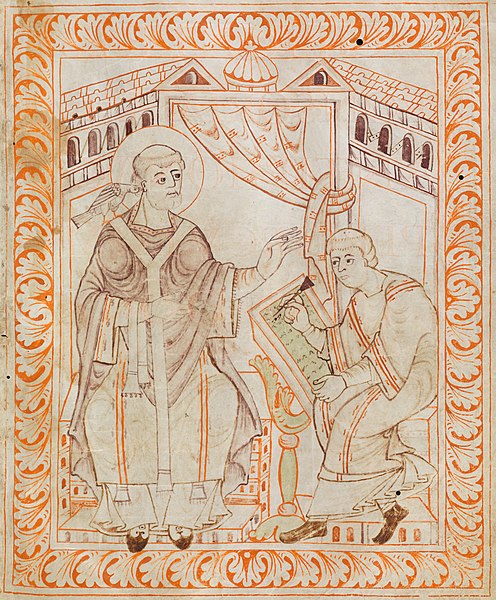The Gregorian mission or Augustinian mission was a Christian mission sent by Pope Gregory the Great in 596 to convert Britain's Anglo-Saxons. The mission was headed by Augustine of Canterbury. By the time of the death of the last missionary in 653, the mission had established Christianity among the southern Anglo-Saxons. Along with the Irish and Frankish missions it converted Anglo-Saxons in other parts of Britain as well and influenced the Hiberno-Scottish missions to continental Europe.
Portrait labelled "AVGVSTINVS" from the mid-8th century Saint Petersburg Bede, though perhaps intended as Gregory the Great
Gregory dictating, from a 10th-century manuscript
Site of the graves of Laurence, Mellitus and Justus at St Augustine's Abbey, Canterbury
Ruins at Canterbury of St Augustine's Abbey, founded by Augustine.
Pope Gregory I, commonly known as Saint Gregory the Great, was the 64th Bishop of Rome from 3 September 590 to his death. He is known for instituting the first recorded large-scale mission from Rome, the Gregorian mission, to convert the then largely pagan Anglo-Saxons to Christianity. Gregory is also well known for his writings, which were more prolific than those of any of his predecessors as pope. The epithet Saint Gregory the Dialogist has been attached to him in Eastern Christianity because of his Dialogues. English translations of Eastern texts sometimes list him as Gregory "Dialogos" from the Greek διάλογος, or the Anglo-Latinate equivalent "Dialogus".
Miniature of Gregory the Great writing, in a 12th-century copy of his Dialogues, British Library, London.
Illumination in a 12th-century manuscript of a letter of Gregory's to Leander, bishop of Seville (Bibl. Municipale, MS 2, Dijon)
Augustine of Canterbury on his mission to Anglo-Saxon England
Mass of St. Gregory, c. 1490, attributed to Diego de la Cruz, oil and gold on panel (Philadelphia Museum of Art)








